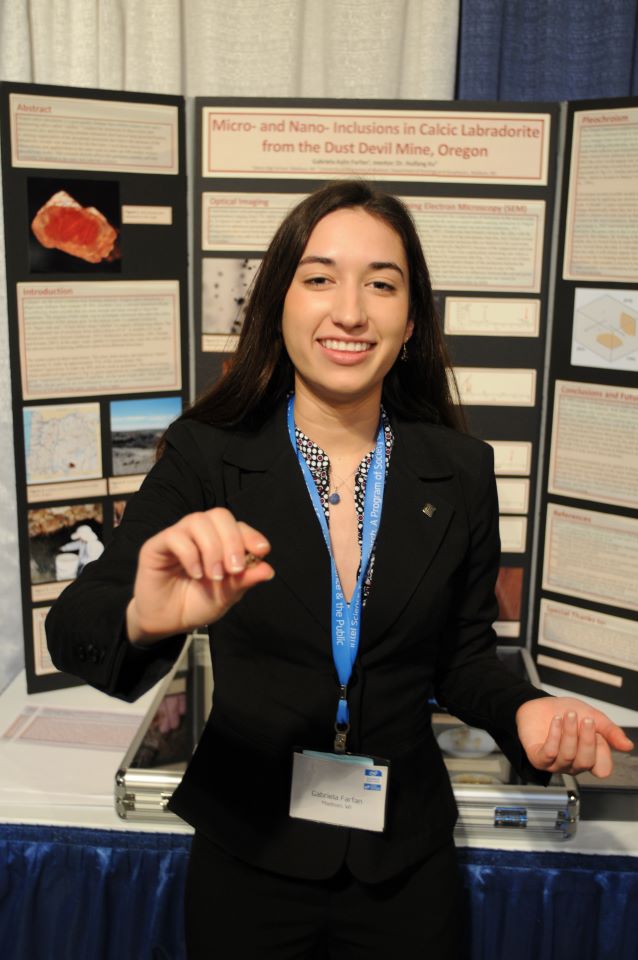A fateful seating arrangement led STS alum, Gabriela Farfan, into her dream world of gems and minerals

This year, the Regeneron Science Talent Search (STS) finalists had the opportunity to go on field trips to several reputable museums and institutions in the Washington D.C. region. Seven finalists took part in a behind-the-scenes tour at the Smithsonian Institute’s National Museum of Natural History (NMNH). Finalists toured the National Gem and Mineral Collection, the laboratories in the Department of Mineral Sciences and were even able to see the famous Blue Room, which is considered one of the most exclusive tours in D.C.
This tour was led by Gabriela Farfan, who came in 10th place in STS 2009 and currently serves as the Coralyn W. Whitney Curator of Gems and Minerals at the NMNH. The excursion offered finalists an opportunity to explore labs at the museum, giving them a peak into career paths that they may not have previously explored.
Ella Pilacek, who came in as the 7th place winner at STS 2024, expressed enthusiasm for “the chance to see the other side of these professional institutions and talk with experts that are usually ‘behind the scenes.’” They also remarked that this type of trip really “showed the diversity of careers in research.”
“This was my favorite part of STS,” said Riya Tyagi, another STS 2024 finalist.
As for Gabriela, she shared that she was originally inspired to pursue curatorial work because museums sparked her love of minerals. “Being able to work as a curator that decides what goes into the National Gem and Mineral Collection and what will go on exhibit at NMNH is a dream come true,” Gabriela said.
For her own STS project Gabriela studied the pleochroism effect, an optical phenomenon in substances, such as crystals, where different colors are manifested when observed at different angles. She worked specifically in Oregon sunstones which she had mined herself in central Oregon during trips with her father. Science has always been a defining part of Gabriela’s life. With two biologists as parents, Gabriela knew from the age of seven that she wanted to become a mineralogist. This path was further honed by her time at STS, which she described as “transformational.”

“It was a great introduction to crystallography, nanotechnology and gem science,” Gabriela said about her research project. “I brought the crystals and the project to a professor at the University of Wisconsin, Madison and he let me work in his lab for several years when I was in high school. Years later, other scientists are still consistently studying these stones, which is exciting.”
On the evening of the 2009 STS gala Gabriela sat next to then-curator of the NMNH’s Gem and Mineral collection, Jeffrey Post. This auspicious seating arrangement sparked a mentorship which would eventually lead to Gabriela stepping into Jeffrey’s role after his retirement in 2023. Jeffrey served as the curator of Gems and Minerals for 32 years, and though he has stepped back from that role he has stayed with the Smithsonian Institute as Curator Emeritus and as a research associate.
This was not the first time Gabriela had met Jeffrey. They first met when she was 16. Gabriela recalled deciding “then and there” that she wanted to pursue a career in gem and mineral curation. Reuniting with Jeffrey at the STS gala allowed them to stay in touch about Gabriela’s academic career until five years ago, when she began working at the NMNH.
Gabriela said that while she always knew she wanted to go into mineralogy, STS gave her “permission to dream even bigger than I had before then. It was the first time that I truly considered what my long-term aspirations were—and believed that they could actually happen.”
“STS taught me to be bolder,” Gabriela said. “I still carry that with me.”
She urges young scientists to “dream big,” and to let their passions guide them when it comes to building a foundation for their future careers. “Find something that you love doing that’s beyond your abilities today, so you can grow into it and become an expert at it tomorrow,” she advised.


